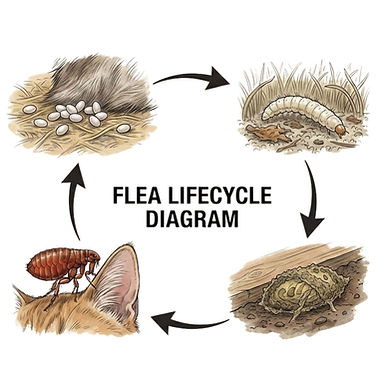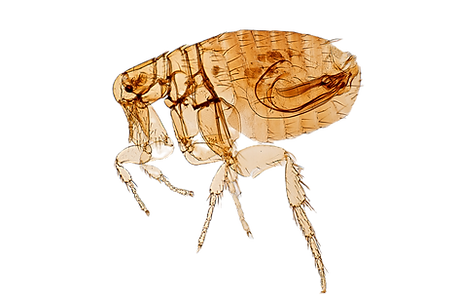Rated 5 stars across all platforms
Local, Award-Winning
Flea Control Experts in
Herefordshire & Worcestershire
Professional Flea Control that actually works
Fleas don't just live on pets - they spread throughout your home. PGM eliminate fleas at every life stage for long-term results, with BPCA-accredited local pest control experts. Providing fast, pet-safe, and affordable flea control fumigation services across Herefordshire and Worcestershire. With RSPH Level 2 & 3 certified technicians, we eliminate flea infestations quickly. Read our Flea FAQs ↗
Are Fleas taking over your home or business?
We Handle It—Fast, Safe, & Hassle-Free.
-
Fast Response - Emergency service options for same-day response
-
Affordable Pricing - Upfront quotes with no hidden fees or surprise charges
-
Expertise - ertified experts trained in safe, efficient flea removal
-
Safe for Families & Pets - Flea control that protects your home
-
24/7 Emergency Callouts - For high-risk situations or allergic reactions
-
Trusted & Highly Rated - 5-star reviews from homeowners and businesses
-
Green & Great - Award-winning solutions that protect people and the planet
Are Fleas Taking Over Your Home?
-
Persistant flea bites on ankles or legs?
-
Pets scratching, biting, or losing fur?
-
Store-bought sprays not working?
-
Fleas returining after treatment?
If any of these sound familiar, you're not alone - flea infestations are one of the most common household pest problems.
Why Fleas Are So Hard to Eliminate?
Fleas multiply quickly and often go unnoticed until bitesr become frequent. While pets usually bring fleas inside, most of the infestation live off the animal - in carpets, furniture, bedding, and floor cracks.
DIY sprays and foggers typlically kill adult fleas only. Eggs and larvae remain hidden,, allowing the infestation to restart within weeks. Without addressing the full flea life cycle, the problem rarely goes away for good.

The Lifecycle of The Flea
1. Egg
Eggs laid on host
or environment
(2-14 days)
2. Larva
Larvae hatch, feed on organic matter
(1-2 weeks)
3. Pupa
Pupae develop in cocoons,
mature into adults
(1 week to months)
4. Adult
Adult fleas jump
onto host for blood
meal, reproduce
(2 weeks to months)
Cycle typically takes 3 weeks to several months depending on conditions
Our Proven Flea Treatment Process
Simple, Safe & Stress-Free
Flea problems can feel overwhelming—but getting rid of them doesn’t have to be. We’ve designed our process to be simple, safe, and stress-free. From your first call to long-term protection, we guide you through every step with clarity, care, and proven industry expertise.
Flea Control Experts You Can Trust
Reach Out
Call, email, or fill out our quick form—we respond promptly and professionally.
Why it matters: Fast, local support when you need it most.
Site Survey
Our RSPH Level 2 trained technicians carry out a thorough inspection of your property.
What you get: Clear findings, honest recommendations, & a tailored action plan.
Treatment
We use safe, targeted methods to eliminate fleas efficiently and discreetly.
Your peace of mind: Effective results with minimal disruption.
Follow-up
We don’t just treat and leave. Our aftercare includes follow-up checks.
Stay protected: Ongoing support and expert guidance, even after treatment.
Flea-Free Living Starts Here!
Why PGM Is the Right Team for the Job
Award-winning flea control treatment and fumigation solutions from PGM & SON, serving homes, rental properties, and businesses across Herefordshire and Worcestershire. As PestPro experts in the UK, we are proud members of the BPCA and specialise in safe, effective flea control treatments tailored for domestic homes, landlords, letting agents, and commercial premises.
Our friendly, family-run team provides in-depth inspections, customised flea eradication plans, and prevention advice to keep your property flea-free. Whether you need a fast-response fumigation, pet- and child-safe treatments, or professional support for managing recurring infestations, we offer expert pest control with proven results. Trust PGM & Son Pest Control to protect your home, tenants, and pets from unwanted fleas!
We don’t just treat the flea symptoms—we target the source, ensuring long-term protection without hidden costs or repeat stress. From flats to family homes, we restore peace of mind with guaranteed results and clear communication every step of the way. Contact us for immediate assistance on 01981 540088 or use the live chat facility on the right hand side of your screen.
Areas we cover ➡ Herefordshire & Worcestershire
We provide fast, effective rodent and flea control services throughout your local area. We offer a professional inspection of your premises. Please call us on (01981) 540088 or send us your contact details and we will contact you asap.
Covering all HR and WR postcodes
All local technicians are highly trained and certified pest controllers
Rated Excellent on Trustpilot Committed to customer service
Environmentally friendly cost effective pest control solutions
PGM Proven Results
10+
Years of
experience
600+
Businesses
protected
4380+
Happy customers
150+
Five star reviews
Over the last decade, we've helped thousands of homeowners and businesses stay flea-free with our award-winning flea control services. As industry-recognised specialists, we know what it takes to deliver fast, effective, long-lasting results. We exist to protect your property, and your peace of mind - every step of the way.
We are proud to be an award-winning flea removal company. Our commitment to quality and excellence has earned us recognition from industry experts and satisfied customers.
We believe that our dedication to staying up-to-date with the latest industry updates and trends sets us apart from our competitors and ensures that we provide the best possible service to our customers.
Herefordshire Locations
Worcestershire Locations
Local Experts in Flea Fumigation for Homes and Rentals
How to Spot the Signs that you may have a Flea Infestation in your Property
01.
Your pets are scratching more than usual
02.
You can see fleas or flea droppings in the coat of your cat or dog
03.
Fleas on pet fur – look for red / brown fleas about 2mm long
04.
Family members being bitten – usually around the ankles or legs
05.
Fleas may be spotted jumping in your carpets or on your furniture
What is Flea Fumigation? and How Do I Prevent Fleas?
Flea fumigation is our no-nonsense approach for homes battling serious infestations. We use a powerful fumigant treatment designed to reach the places fleas love to hide—deep in carpets, soft furnishings, and hard-to-spot cracks. This intensive service targets fleas at every stage: eggs, larvae, and adults, helping break the cycle fast. It’s ideal for situations where standard sprays just aren’t enough, offering full-home coverage and long-term relief you can count on.

“We had a flea infestation in one of our rental properties and PGM were able to attend in the same week. They kept us informed, provided written advice on cleaning and explained how the pesticide works. 5 stars all around!”
MyFriendlyGiant, Google Review
Pet Safe & Environmentally Friendly Pest Control
We are committed to environmentally friendly pest control services. Our mission is to provide you with a pest control program that is proactive, preventative, and delivers optimal effectiveness. Living in this beautiful rural community and having kids and pets of our own, we SHARE your concerns. We adopt practices that minimise exposure to the environment, wildlife and other non-target species.
Our local qualified and accredited pest technicians are (BPCA) British Pest Control Association certified. Whether it’s your home or business, our expert team ensures swift and efficient pest elimination for complete peace of mind. Your peace of mind is our priority


Flea Control Service throughout Herefordshire & Worcestershire
Ridding a home of fleas can be a frustrating and costly endeavor. Unlike some pests encountered around the home, fleas cause discomfort and irritation to both pets and people.
They account for more than half of all dermatological conditions requiring veterinary assistance, and even a single flea bite to a hypersensitive animal or person may cause intense itching and irritation. It would be a grave mistake to think of the flea as simply a nuisance.
Fleas (Siphonaptera)
There are many species of fleas – around 1400 and there are perhaps up to 60 species in Britain. It is believed that they have evolved from a group close to flies because flea larvae and fly larvae are very similar.
All adult fleas are external parasites of warm blooded animals and birds. Extreme specialisation has resulted in them looking unlike any other group of insects.
From Flea prevention and protection to removal and elimination


Cat Flea (Ctenocephalides Felis)
Habitat
-
Parasitic as adults
-
Live among the fur of its host, feeding on its blood
-
Larvae live on floor or in bedding of host
-
Mainly feeding on droppings (faeces) of adults
Breeding
-
Egg, larva, pupa, adult
-
Number of eggs – up to 1000 for female
-
Eggs hatch in a few days
-
Larvae are legless, up to 5mm in length
-
Thrive best in humid places
-
They have 2-3 moults
-
It takes 3 weeks for them to be fully grown
-
Pupa emerge in 2-4 weeks in respon.se to vibration; they will not emerge if unstimulated
-
Adult size is around 2mm long, they are brown and wingless with large hind legs for jumping
Control Measures
-
Treatment of host animal using veterinary products only
-
Vacuuming (disposing of the bag and its contents safely)
-
Cleaning or disposing of bedding
-
Treatment of carpets and flooring with an appropriate insecticide (by a trained professional, such as PGM & Son Pest Control)
-
Use residua products, possibly with growth regulators
The cat flea is by far the most common flea in the UK which comes into contact with humans. And, despite its name, it is common on dogs too. The adult flea spends a variable proportion of its time on the host, resting in the sleeping and bedding area.
Nobody wants an flea infestation and the best way to help prevent fleas is to take some simple precautions. Pets are the main source of transporting fleas in the home.To get rid of cat fleas or dog fleas you should seek help from a professional pest control company, get in touch with us today.
The Ultimate Flea Blog Hub:
Read, Learn, Explore
We love sharing our knowledge with our customers!
We believe knowledge is power—especially when it comes to fleas. Whether you’re wondering how they spread, puzzled by their life cycle, or just want practical tips to keep your home itch-free, we’ve got you covered. Dive into our articles about flea control to uncover how these tiny pests operate—and more importantly, how to stop them in their tracks.
Flea Facts You Didn't Know!
How do fleas enter a home or business?
Fleas can enter a home or business through several ways, such as on pets, through open windows or doors, or on second-hand furniture or clothing.
What are the signs of fleas in a building?
The signs of fleas in a building include bites on the skin, spotting fleas or flea dirt (black specs of digested blood) on pets or surfaces, and excessive scratching or licking by pets.
How can fleas be prevented?
Fleas can be controlled and prevented by regularly vacuuming and washing pet bedding, treating pets with flea medication, sealing cracks and gaps in the building, and regularly inspecting and treating second-hand furniture before bringing it inside.
Is it possible to get rid of fleas completely?
Yes! Getting rid of fleas completely can be difficult, but with professional treatment and preventive measures, it is possible to significantly reduce their numbers.
How long does a flea treatment take?
The length of time for flea treatment varies depending on the severity of the infestation and the effectiveness of the treatment used. However, it typically takes several weeks to several months to completely eliminate fleas.
What are the potential health risks associated with a flea infestation?
Flea infestations can pose a risk to the health of pets and humans, as fleas can transmit diseases and cause skin irritation and infection.
How can I prevent a flea infestation?
To prevent flea infestations from recurring, it is important to maintain a clean and hygienic environment, regularly treat pets with flea medication, and regularly inspect and treat second-hand furniture before bringing it inside.
What do fleas look like?
Fleas are tiny, wingless insects measuring about 1.5 to 3 mm in length. They have flat, narrow bodies that allow them to move easily through fur, and their color ranges from reddish-brown to dark brown. Equipped with six legs, their hind pair is particularly strong, allowing them to jump impressive distances. Fleas have a hard exoskeleton and are covered in backward-facing hairs that help them cling to their host. Their mouthparts are designed for piercing skin and feeding on blood.
How do I know if my pet has fleas?
Pets with fleas often scratch, bite, or lick themselves more than usual — especially around the neck, tail base, and belly. You might notice small red bumps or scabs on their skin, or patches of hair loss. Flea dirt (tiny black specks that turn reddish when wet) may be visible in their fur or bedding. Using a flea comb can help you spot adult fleas or flea dirt more easily. If you’re unsure, place your pet on a white towel and brush their coat — any fleas or flea dirt will be easier to see against the light background.
Can fleas live in my home even if I don’t have pets?
Fleas don’t need pets to survive — they can enter your home by hitching a ride on clothing, second-hand furniture, or even through wildlife like rodents or stray animals. If the previous occupants had pets, flea eggs and larvae may still be lurking in carpets, upholstery, or floorboards. Fleas are resilient and can survive for weeks without a host, hiding in warm, dark places until they detect movement, heat, or carbon dioxide from a potential host — including humans. That’s why even pet-free homes can experience infestations.
When are fleas most active in the UK?
Fleas are most active in the UK during the warmer months, typically from June to September, when heat and humidity create ideal conditions for reproduction. However, thanks to central heating, fleas can remain active indoors year-round, especially in autumn and winter when they seek warmth inside homes.
Even without pets, homes can still host fleas — they may arrive via wildlife, second-hand furniture, or lingering eggs from previous infestations. That’s why consistent flea prevention is recommended throughout the year, not just in summer.










.png)





